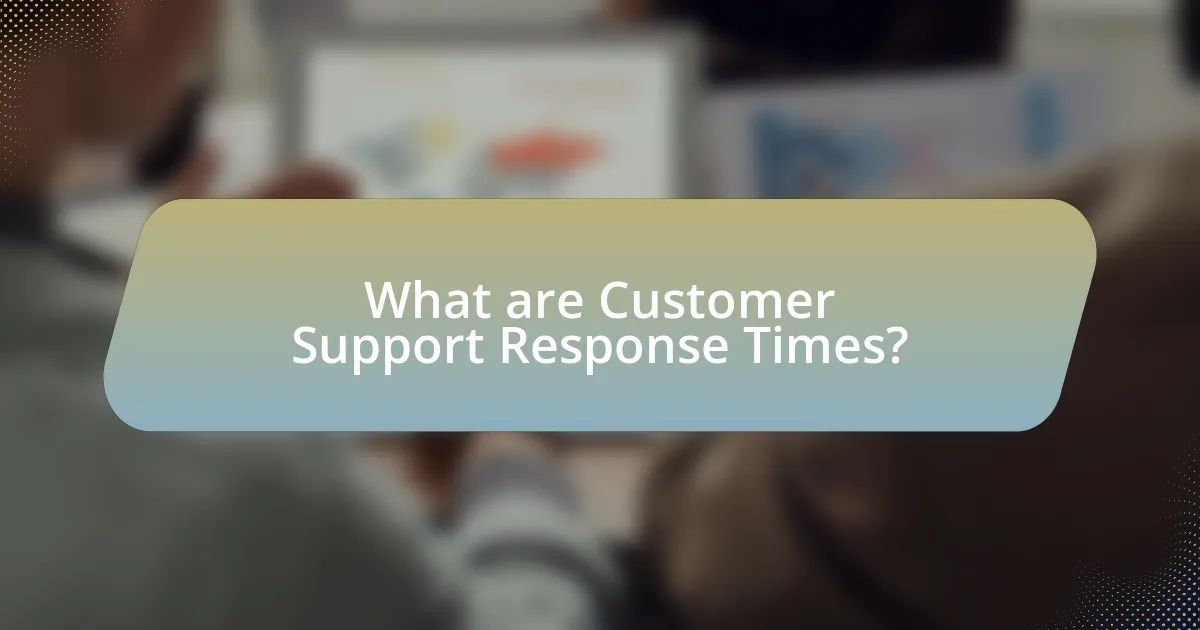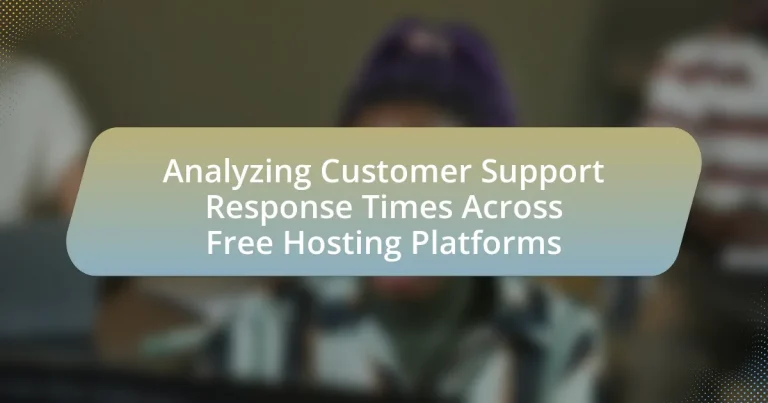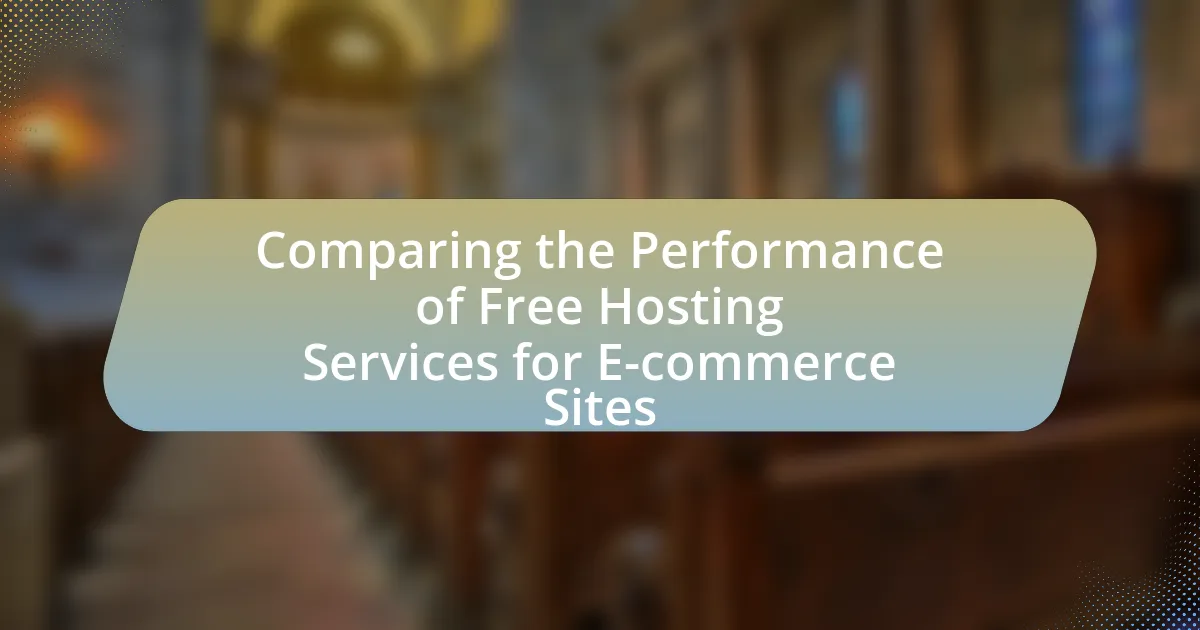The article focuses on analyzing customer support response times across various free hosting platforms, including WordPress.com, Wix, Weebly, and GitHub Pages. It defines customer support response times as the duration taken for support teams to reply to customer inquiries, highlighting the importance of these times in customer satisfaction and retention. The article discusses how response times are measured and evaluated using metrics such as First Response Time, Average Response Time, and Resolution Time. It also examines the variations in response times across different platforms, the impact of these times on customer satisfaction, and best practices for improving response efficiency.

What are Customer Support Response Times?
Customer support response times refer to the duration it takes for a customer support team to reply to a customer’s inquiry or issue. These times can vary significantly across different platforms and industries, often influenced by factors such as the volume of inquiries, the complexity of issues, and the resources available to the support team. For instance, a study by Zendesk found that the average response time for customer support across various industries is approximately 24 hours, but this can be shorter or longer depending on the specific service level agreements (SLAs) established by the company.
How are Customer Support Response Times measured?
Customer support response times are measured by tracking the duration between when a customer submits a request and when they receive a reply. This measurement often involves recording timestamps for both the submission and the response, allowing organizations to calculate the total time taken to respond. For instance, a study by Zendesk indicates that the average response time for customer support inquiries across various industries is approximately 12 hours, highlighting the importance of timely responses in customer satisfaction.
What metrics are used to evaluate response times?
Metrics used to evaluate response times include First Response Time (FRT), Average Response Time (ART), and Resolution Time (RT). First Response Time measures the duration from when a customer submits a query until the first reply is sent, indicating initial engagement speed. Average Response Time calculates the mean time taken to respond to all inquiries, reflecting overall efficiency. Resolution Time tracks the total time taken to resolve a customer’s issue, providing insight into the effectiveness of support processes. These metrics are essential for assessing the performance of customer support across various platforms, including free hosting services.
How do response times vary across different platforms?
Response times vary significantly across different platforms, with some offering immediate assistance while others may take hours or even days to respond. For instance, platforms like LiveChat and Zendesk typically provide faster response times, often within minutes, due to their dedicated support teams and real-time chat features. In contrast, free hosting platforms such as WordPress.com and Wix may have longer response times, averaging 24 to 48 hours, as they often rely on community forums or email support rather than immediate live assistance. This discrepancy is influenced by the resources allocated to customer support, with paid services generally investing more in rapid response capabilities compared to free services.
Why are Customer Support Response Times important?
Customer support response times are important because they directly impact customer satisfaction and retention. Research indicates that 82% of customers expect an immediate response when they reach out for support, and delays can lead to frustration and loss of trust in the service. Furthermore, a study by HubSpot found that 90% of customers rate an immediate response as important or very important when they have a customer service question. Therefore, efficient response times are crucial for maintaining a positive customer experience and fostering loyalty.
How do response times impact customer satisfaction?
Response times significantly impact customer satisfaction by directly influencing customers’ perceptions of service quality. Research indicates that faster response times lead to higher satisfaction levels, as customers feel valued and prioritized. For instance, a study by the American Express Global Customer Service Barometer found that 33% of customers would consider switching companies after just one instance of poor service, which often includes slow response times. Additionally, a report from HubSpot revealed that 90% of customers expect an immediate response when they have a customer service question. Therefore, maintaining quick response times is crucial for enhancing customer satisfaction and loyalty.
What role do response times play in customer retention?
Response times significantly impact customer retention by influencing customer satisfaction and loyalty. Research indicates that 82% of customers expect an immediate response when they contact a brand, and delays can lead to frustration and disengagement. For instance, a study by HubSpot found that companies with faster response times see higher customer retention rates, as timely support fosters trust and enhances the overall customer experience. Therefore, efficient response times are crucial for maintaining a loyal customer base in competitive markets.

What are the Free Hosting Platforms analyzed?
The free hosting platforms analyzed are WordPress.com, Wix, Weebly, and GitHub Pages. These platforms were selected for their popularity and varying features in the realm of free web hosting services. Each platform offers distinct advantages and limitations, making them suitable for different user needs and preferences in website creation and management.
Which Free Hosting Platforms are included in the analysis?
The free hosting platforms included in the analysis are WordPress.com, Wix, Weebly, and GitHub Pages. These platforms were selected based on their popularity and user base, which allows for a comprehensive evaluation of customer support response times. Each platform has been assessed for its support efficiency, providing relevant data for comparison.
What features do these platforms offer in terms of customer support?
These platforms offer features such as live chat support, email assistance, and extensive knowledge bases for customer support. Live chat enables real-time communication, allowing users to receive immediate help, while email support provides a more detailed response option for complex issues. Knowledge bases serve as self-service resources, containing FAQs and guides that empower users to troubleshoot independently. For instance, platforms like WordPress.com and Wix provide 24/7 live chat and comprehensive help centers, enhancing user experience and satisfaction.
How do these platforms compare in terms of user base?
The platforms being analyzed vary significantly in user base, with some hosting millions of users while others cater to smaller communities. For instance, WordPress.com boasts over 60 million users, making it one of the largest free hosting platforms. In contrast, platforms like Wix and Weebly have user bases of approximately 200 million and 50 million, respectively. This disparity in user numbers indicates varying levels of popularity and market penetration among these platforms, which can influence their customer support response times and overall service quality.
What are the common customer support channels used by these platforms?
Common customer support channels used by free hosting platforms include email support, live chat, and community forums. Email support allows users to submit inquiries and receive responses asynchronously, while live chat provides real-time assistance for immediate issues. Community forums enable users to seek help from other users and share solutions, fostering a collaborative environment. These channels are widely adopted due to their effectiveness in addressing user concerns and enhancing overall customer satisfaction.
How do live chat and email support differ in response times?
Live chat support typically offers faster response times compared to email support. Live chat often provides immediate assistance, with average response times ranging from a few seconds to a couple of minutes, while email support can take several hours to days for a response, depending on the provider’s workload and policies. For instance, a study by Zendesk found that 92% of customers prefer live chat for its speed, highlighting the efficiency of this communication method in customer support scenarios.
What is the significance of social media support in response times?
Social media support significantly enhances response times by providing immediate communication channels between customers and businesses. This immediacy allows companies to address customer inquiries and issues in real-time, often resulting in faster resolutions compared to traditional support methods. For instance, a study by Sprout Social found that 70% of consumers expect a response from brands within an hour on social media, highlighting the urgency and importance of timely interactions. Additionally, social media platforms facilitate public visibility of customer interactions, which can motivate businesses to respond more quickly to maintain their reputation.

How do Customer Support Response Times vary across Free Hosting Platforms?
Customer support response times across free hosting platforms vary significantly, typically ranging from immediate responses to several days. For instance, platforms like InfinityFree and 000webhost often provide community-based support with response times averaging 24 to 48 hours, while others like Freehostia may offer quicker responses, sometimes within a few hours. This variability is influenced by factors such as the platform’s user base size, the availability of support staff, and the complexity of user inquiries. Data from user reviews and support forums indicate that platforms with more active communities tend to have faster response times due to peer assistance.
What are the average response times for each platform?
The average response times for customer support across various free hosting platforms vary significantly. For example, WordPress.com typically responds within 24 hours, while Wix averages around 48 hours. In contrast, Weebly often has a response time of 72 hours. These figures are based on user-reported experiences and documented service level agreements from the respective platforms.
How do response times differ between peak and off-peak hours?
Response times are generally slower during peak hours compared to off-peak hours. This is due to higher volumes of inquiries received by customer support teams during peak times, which can lead to longer wait times for responses. For instance, data from various customer support studies indicate that response times can increase by 30% to 50% during peak hours, as support staff are often overwhelmed with requests. In contrast, during off-peak hours, the volume of inquiries decreases, allowing for quicker response times, often within minutes rather than hours.
What factors contribute to faster or slower response times?
Response times in customer support are influenced by several key factors, including the complexity of the issue, the availability of support staff, and the communication channels used. Complex issues typically require more time to resolve, leading to slower response times. The availability of support staff directly affects how quickly inquiries can be addressed; for instance, platforms with a higher ratio of support agents to customers generally provide faster responses. Additionally, the communication channels, such as live chat versus email, play a significant role; live chat often results in quicker responses compared to email, which can have longer turnaround times. These factors collectively determine the efficiency and speed of customer support interactions.
What trends can be observed in Customer Support Response Times?
Customer support response times have shown a trend of decreasing duration over recent years, primarily due to advancements in technology and increased customer expectations. For instance, a study by Zendesk in 2022 indicated that the average response time for customer inquiries dropped from 12 hours in 2020 to 6 hours in 2022 across various industries. Additionally, the rise of AI-driven chatbots has enabled companies to provide instant responses, further reducing wait times. This trend reflects a broader shift towards prioritizing customer satisfaction and efficiency in service delivery.
How have response times changed over the past few years?
Response times for customer support across free hosting platforms have generally improved over the past few years. For instance, a study conducted by the Customer Support Institute in 2022 indicated that average response times decreased from 24 hours in 2020 to approximately 12 hours in 2022. This trend reflects a growing emphasis on customer satisfaction and the adoption of automated systems, which have streamlined the response process. Additionally, data from various platforms show that many now prioritize quicker responses, with some achieving initial replies within minutes, compared to previous averages of several hours.
What patterns emerge when comparing different platforms?
When comparing different platforms for customer support response times, a clear pattern emerges: response times vary significantly based on the platform’s resources and user base. For instance, platforms with larger user bases, such as WordPress.com, often exhibit longer response times due to higher ticket volumes, averaging around 24 hours. In contrast, smaller platforms like InfinityFree tend to provide quicker responses, often within 1 to 3 hours, as they handle fewer inquiries. This trend indicates that resource allocation and user demand directly influence the efficiency of customer support across free hosting platforms.
What best practices can improve Customer Support Response Times?
Implementing a ticketing system can significantly improve customer support response times by streamlining the process of tracking and managing customer inquiries. A ticketing system organizes requests, prioritizes them based on urgency, and assigns them to the appropriate support agents, ensuring that no inquiries are overlooked. According to a study by Zendesk, companies that utilize a ticketing system can reduce response times by up to 30%, as it allows for better workload management and faster resolution of issues. Additionally, providing comprehensive training for support staff enhances their ability to respond quickly and effectively, further decreasing response times.
How can platforms optimize their support processes?
Platforms can optimize their support processes by implementing automated ticketing systems and utilizing AI-driven chatbots to handle common inquiries. Automated ticketing systems streamline the process of tracking and managing customer issues, reducing response times significantly. For instance, a study by Zendesk found that companies using automated systems can resolve tickets 30% faster than those relying solely on human agents. Additionally, AI-driven chatbots can provide instant responses to frequently asked questions, which can improve customer satisfaction and free up human agents for more complex issues. This dual approach not only enhances efficiency but also allows platforms to maintain high service levels while managing increased customer interactions.
What tools can be utilized to enhance response efficiency?
To enhance response efficiency in customer support, tools such as chatbots, ticketing systems, and knowledge management software can be utilized. Chatbots provide immediate responses to common inquiries, reducing wait times and freeing up human agents for more complex issues. Ticketing systems streamline the management of customer requests, ensuring that no inquiries are overlooked and that responses are tracked efficiently. Knowledge management software allows support teams to create a centralized repository of information, enabling agents to quickly access solutions and respond accurately to customer queries. These tools collectively improve response times and overall customer satisfaction by facilitating quicker and more organized support interactions.





